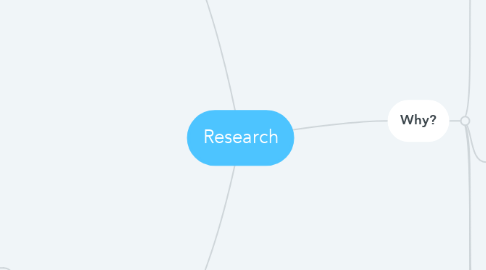
1. Research
1.1. why?
1.1.1. Building on the evidence base
1.1.1.1. Strengthening existing evidence base
1.1.2. To identify gaps in research
1.1.2.1. Identify where deficits are
1.1.2.1.1. lack of evaluation
1.1.2.1.2. tools to measure
1.1.2.1.3. capturing the important benefits of groupwork
1.1.2.1.4. what are the challenges?
1.1.3. To identify gaps in service and evaluation
1.1.4. Validate spending money on group programs
1.1.5. Meet planning goals and targets (eg; workload splits 80/20 individual work/other types of work
1.2. Gaps
1.2.1. Literature review findings
1.2.2. What is the gap identified leading to this research?
1.2.3. What is the gap being filled
2. Gaps
2.1. Literature review findings
2.1.1. Challenges associated with diversity of groupwork interventions
2.1.1.1. difficulty of finding a solid evidence base for one type of intervention that has a wide reach
2.1.1.2. variables associated with applying a single model to all services
2.1.1.3. post modernist viewpoint acknowledges multiple realities/perspectives/distribution of power
2.1.1.4. variables such as facilitator/group dynamics/location/resourcing/budgets/engagement etc.
2.1.2. Finding commonalities
2.1.2.1. Good facilitation
2.1.2.1.1. Must be knowledgeable and trained in trauma informed practice and framework for practice
2.1.2.1.2. Good listener
2.1.2.1.3. Must be able to hold group emotions/feelings/trauma
2.1.2.1.4. Must be adaptable/innovative
2.1.2.1.5. Good sense of humour
2.1.2.1.6. bond/relationship with group members
2.1.2.2. Location important
2.1.2.2.1. business of traffic distracting
2.1.2.2.2. safety an issue for those experiencing violence.
2.1.2.2.3. a place where people can relax
2.1.2.3. Good screening pre intervention
2.1.2.3.1. important for engagement
2.1.2.3.2. made participants feel safer to attend
2.1.2.3.3. Gave therapists opportunity to assess readiness and suitability of participants
2.1.2.4. Quiet safe location for groups to run
2.1.2.5. Length of time internvention runs for
2.1.2.5.1. Average of 8-12 weeks
2.1.2.5.2. Longer time frame did not necessarily yield better results
2.1.2.5.3. Too short an intervention did not create enough effect.
2.1.2.5.4. sometimes short interventions lead to attendance at longer ones
2.2. What is the gap being filled?
2.2.1. Supporting development of an evaluation framework for groupwork
2.2.2. identifying commonalities of good groupwork
2.2.3. Contributing to the evidence base for groupwork
2.2.4. identifying challenges and benefits of successful groupwork
2.3. What is the gap identified that lead to the research?
2.3.1. lack of comprehensive evaluation and longer term evaluation of effectiveness of groupwork
2.3.2. The need for a strong evidence base to support the work of LCCASA.
3. Why?
3.1. Building on the evidence base for groupwork?
3.1.1. Measurement methodologies trauma/anxiety/depression scales/pre-post evaluations/interviews
3.1.1.1. Does there need to be more consideration of what should be measured?
3.1.1.1.1. social connection?
3.1.1.1.2. Was it a turning point in recovery?
3.1.1.1.3. value of group identity to recovery
3.1.1.1.4. long term gains
3.1.2. Lack of RCTs for this client group
3.1.2.1. Will most likely not occur due to cost
3.1.2.2. Evaluation measures in RCTs do not capture complexity of group experience
3.1.2.3. Questions around how do you measure success or benefits to participants
3.1.3. Lack of uniformity/need for a more universal evaluation tool?
3.2. Establishing an evaluation framework
3.2.1. Area flawed
3.2.1.1. Problematic due to diversity of populations/variety of interventions
3.2.2. Time and limitations of organisations
3.2.2.1. Feedback from orgs indicates lack of time/resources for longitudinal evaluations
3.2.3. possibility of partnerships with other orgs
3.2.3.1. A possibility to overcome resource issue
3.2.3.2. Creates greater benefit/more value
3.2.4. Not enough evaluation being done
3.2.4.1. Literature supporting this AIHW/HR/ABS
3.2.5. Cost associated with RCTs and/or qualitative research.
3.2.5.1. Is there a better way to evaluate over large populations?
3.2.5.2. Limited resources/value placed on evaluation
3.3. To identify gaps in service
3.3.1. No groups run specifically for sexual abuse survivors w/i Loddon Campaspe
3.3.2. Community groups isolated from support for this issue e.g. CALD/ATSI/LGBTQI
3.4. Validate spending money on group programs
3.4.1. Evidence base needs to support this from a budgeting/organisational perspective.
3.5. Meet planning goals and targets (eg:
3.5.1. distribution of labour for CAs must include an 80/20 split between individual counselling and groupwork.
3.5.2. Pressure from outside e.g. other orgs/CASAs are offering group programs
